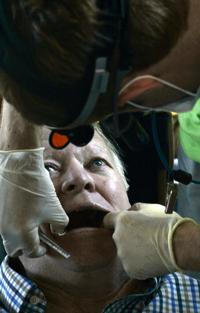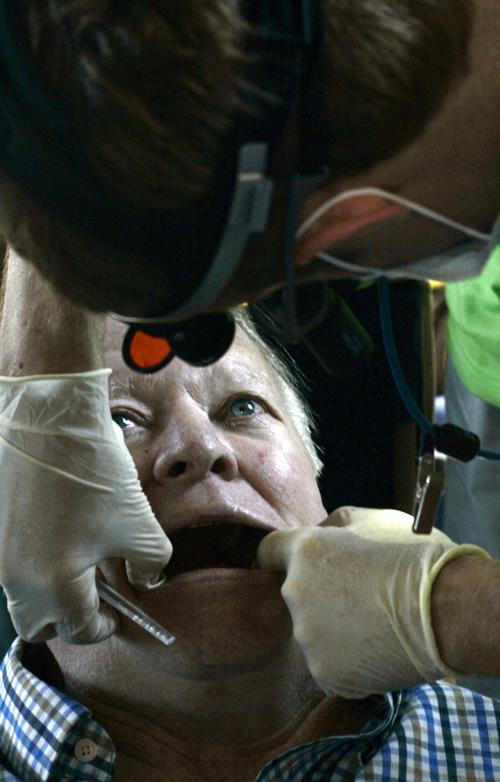Local dentists who for years volunteered their services at Tucson’s Hope Fest are skipping this weekend’s charity gathering, working instead on a way to offer free care on a more ongoing basis.
The need for free dental care here is too huge to offer it in a one-day event like Hope Fest, they say. The annual event for low income residents offers free hygiene items, haircuts and medical services, among other things, and regularly attracts upward of 10,000 people. It was set for Saturday at the Tucson Convention Center.
For the first time in at least 20 years, no dental services were to be offered.
In recent years, the dental component at Hope Fest attracted about 250 volunteers, including 75 dentists, to give free care to 400 to 600 local residents in one day. Spots for dental care at past events were limited, so people, frequently suffering from severe dental problems, often tried to camp out the night before, even though organizers prohibited it. Arguments often erupted in the line over getting one of the coveted spots.
Hope Fest organizer Lisa Chastain told the Star last week that she hopes to offer dental care in some form at Hope Fest 2018. The 25-year-old event is operated by the nonprofit Hope Network Inc.
But volunteer dentists, led by longtime Hope Fest dental director Dr. Dean Hauseman, say the local need is simply too big to handle in one day. There has to be a better way to help, he said.
“We’re not bailing. But we were not making any progress,” said Hauseman, who is a local endodontist. “We need some sort of delivery system in Tucson to offer dentistry to the underserved that is not just a one-day event.”
Hauseman and other local oral health advocates, including leaders of the Arizona Dental Association, will be meeting next month to discuss a future where dentists will no longer volunteer at Hope Fest. Rather, they’d like to be volunteering doing something that’s more regular and effective.
“Charitable dental events like this are just like putting a Band-Aid on a big problem. Our problem is systemic,” said Kevin Earle, executive director of the Arizona Dental Association.
“Part of the idea is perhaps we could do things several times a year instead of once a year. That way it becomes more of an ongoing resource in the community and we can get folks engaged, and provide something more comprehensive.”
Dental problems are closely tied to poverty and at 19 percent, Pima County’s poverty rate is higher than both the national and state levels.
Left untreated, dental health problems can cause pain and tooth loss, impede productivity and job opportunities, cause problems speaking, eating, learning and complicate the detection of oral cancers.
People without dental care are vulnerable to heart and kidney disease, diabetes, high blood pressure and even premature death.
Care deficit
One in four Pima County residents — nearly 300,000 people — are covered by Medicaid, a government insurance program for low income people. Medicaid in Arizona, which is called the Arizona Health Care Cost Containment System (AHCCCS) does not cover comprehensive dental care for adults over the age of 21.
Until recently, Arizona was one of just four states in the U.S. that offered no dental care at all to adults enrolled in Medicaid. The state slashed all dental coverage for adults in 2010 and it was that action that only aggravated the dental problems among attendees at Hope Fest, Earle sad.
“That’s how Hope Fest morphed. After seven years of not having any resources, they are essentially without any teeth or have a few teeth left,” he said.
Beginning Oct. 1, adults over the age of 21 who are on AHCCCS (Medicaid) have been allowed use up to $1,000 per year for emergency dental care. It’s a start, but oral health care advocates say real progress with dental health will occur when AHCCCS begins covering comprehensive dental care, including preventive visits, for adults.
“The reinstated Medicaid benefit only covers patients in the case of a dental emergency and only provides up to $1,000 worth of care. While a step in the right direction, this limited insurance coverage does not guarantee access to dental care,” said Kristen Mizzi Angelone, a dental campaign officer with the Pew Charitable Trusts.
“In Arizona, only about one third of dentists see any patients on Medicaid. And in many areas of the state, including rural communities and tribal lands, dental providers are scarce, leaving people to travel significant distances just to get to an oral health care provider.”
And the new AHCCCS dental benefit won’t pay for preventive care, like screenings and teeth cleanings. It’s limited to emergency care associated with pain and infection.
“We’re hoping eventually we can be a kinder, gentler state and have a comprehensive dental benefit for adults at these income levels,” Earle said. “It will help build a more robust structure, a better safety net system. That is our big goal, ultimately.”
Oral health isn’t just a problem for people on Medicaid/AHCCCS. Medicare, a government health insurance program that predominantly covers people over the age of 65, does not pay for dental care.
And other working Arizonans are earning too much to qualify for AHCCCS, yet not enough to afford expensive dental bills, dental providers say.
Low cost clinics like El Rio Community Health Center are helping, but they cannot afford to consistently offer free care.
Some subsidies are available through the El Rio Foundation for people with no other means to pay, but there’s not nearly enough money nor are there enough providers serving low income patients, said Alicia Thompson, the manager of the dental department at El Rio and also coordinator of the Southern Arizona Oral Health Coalition.
“We operate at maximum capacity with the current providers we have,” Thompson said of El Rio. “We don’t have the capacity and there aren’t enough dentists graduating that are willing and want to work in a safety net provider facility, like a federally qualified health center.”
El Rio serves 95,000 individual patients per year, but only 23,000 of them are getting their dental care there, officials said. Thompson said she suspects many of the remaining 72,000 El Rio patients are getting no oral health care at all.
The people who are camping overnight for Hope Fest, spending hours standing in line to get dental care, are making choices between food, rent and oral health, Thompson said.
“They are put into such a hard position. They are in pain but also have a family to feed, to keep a roof over their head. So they live with the pain,” said Thompson, whose coalition will be working with Hauseman on a post-Hope Fest plan.
The need, she said, is, “astronomical.”
Denture-fest
One problem with Hope Fest was that people would get a procedure like a root canal, but couldn’t afford the next step, to then put a crown on it. There was no follow-through, Hauseman said.
Also, in recent years, Hope Fest became what Hauseman calls a “denture-fest” as word got out that a limited number of dentures were being offered. People began referring to dentures as the, “golden ticket.”
“It became a monster that got out of control,” Hauseman said. “I’ve done it for 20 years and I’ve seen the evolution of the whole project. … Dentures are wonderful and change people’s lives, but they are expensive and time-intensive.”
Demand for dentures was overwhelming other services like fillings, root canals and preventive care, Hauseman said.
“We lost what we were doing with Hope Fest, which started out with more generalized treating of fillings, cleanings and maybe root canals,” Hauseman said.
Then this year Hope Fest moved venues from Kino Memorial Veterans Stadium to the Tucson Convention Center, which was not as conducive to offering dental services, Hauseman said. It was an opportunity for the dental volunteers to reconfigure how to best meet the community’s vast oral health needs.
Any money donated to Hope Fest’s dental program is now going to the Arizona Dental Foundation, which is the state association’s charitable arm, until a new solution is found.
Moving forward, Hauseman hopes to re-direct the efforts that went into offering dental services at Hope Fest into a “better vehicle” to deliver dentistry to the underserved.
“We’ve got to use our collective brain power and find a solution to what we are doing here,” he said. “It’s got to be something where volunteer dentists go to a clinical site on a routine basis, so we can provide more comprehensive care to these people.”





